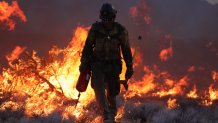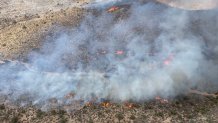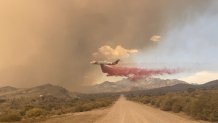
The York Fire has burned more than 80,000 acres, roughly one-fourth the size of the city of Los Angeles. It's currently the largest wildfire in the state this year.
The fire began on private land in the Mojave National Preserve on July 28, according to a press release from the National Parks Service. The flames have since spread over across the New York Mountains, San Bernardino County and Clark Country, Nevada.
So far this year, “30,466 wildfires have burned 1,174,562 acres in the United States,” according to a Tweet from the National Interagency Fire Center.
The York Fire has consumed Pinyon pines, Utah junipers and Joshua trees and displaced all kinds of animals in its wake. Nearly 400 people are working to contain and suppress the fire and prevent it from destroying more land, but the blaze's thick smoke has challenged their efforts.
Get Southern California news, weather forecasts and entertainment stories to your inbox. Sign up for NBC LA newsletters.
“With visibility up to a mile or less in some areas it has a significant implication and causes hazardous conditions, hindering firefighting operations as it affects aerial support, ground crews’ movement, and communications between firefighting units,” the NPS press release stated.

Marc Peebles is the public information officer at California Incident Management Team 13 and a retired battalion chief for the San Bernardino County Fire Department.
Local
Get Los Angeles's latest local news on crime, entertainment, weather, schools, COVID, cost of living and more. Here's your go-to source for today's LA news.
Peebles said that the state’s “robust winter” has promoted the growth of vegetation. In the summer, those plants dry out and carry the fire farther. California’s monsoon season runs from mid-July to September, and Peebles added that strong monsoonal winds have also allowed the fire to spread.
He highlighted that the firefighters are “doing a really good job and they're making progress.” They have been able to contain 30% of the fire, by creating a barrier to stop it from spreading.
The National Parks Service is conducting an investigation into what caused the blaze, Peebles said.
The animals and the trees
Neal Darby, a wildlife biologist at the preserve, said that seeing the loss of the wetlands is “heart-wrenching,” but he highlighted that “nature is very resilient.”
The biggest concern following the fire is the dead and burned plants. “Until things can start regrowing, there's nothing for these animals to eat,” he said.
Animals that once benefited from the trees' cool shade will have to find relief from the sun elsewhere, Darby said, while other animals that prefer the open space will move onto the burned land. For example, bighorn sheep dislike wooded areas, so they will likely go into areas without trees, he added.
Darby said that water sources have been impacted by the fires as well, so animals, like the mule deer, will move elsewhere in search of water. Since mountain lions hunt deer, they will follow where their prey goes.
Though Darby said it will be “a slow process” for the reserve to regrow, he is “optimistic.”
He explained that it will take a few years for grasses to return, four to five years for a significant amount of shrubs to appear and 20 to 30 years for the woodland to grow.
This growth depends on certain climatic conditions, such as droughts, which scientists say have become more frequent with climate change, according to Darby. Darby fears that the precipitation patterns in the area will continue to shift. Right now, there is less rain overall, but when it rains, there is a downpour, he said.
Darby has seen the vegetation grow at higher elevations to adjust to these changes, and he said that the animals that depend on those plants follow them to higher grounds.
“I do see a lot more tortoises in the foothills of the mountains than we typically used to see,” he said.
Dealing with smoke
Nevada’s Department of Conservation and Natural Resources wrote in a blog post that smoke pollution has increased from the “record-breaking temperatures and extreme drought fueling catastrophic wildfires across the west.”
Wildfires often worsen the air quality for short periods of time, as they bring certain chemicals into the atmosphere. Poor air quality can create health issues for all people, by irritating the eyes, nose, throat and lungs.
Nevada’s DCNR recommends that people pay close attention to local air quality, avoid the outdoors if it looks hazy and reduce smoke in homes and vehicles by closing windows and using AC in recirculate mode.
Peebles said people should refer to Cal Fire’s Ready, Set, Go! Wildfire Action Plan, which teaches people about how to protect themselves and their family members from wildfires.

One ranger reflects on climate change after seeing the damage of wildfires
“My heart dropped,” Sierra Willoughby, a supervisory park ranger at Mojave National Preserve, recalled. They were on a camping trip with friends when their coworkers called to tell them about the York Fire.
“Seeing big fires happen all the time makes me feel like we're living in a new time and none of this beautiful habitat I see around me is safe,” they said, referring to the 2020 Dome Fire and the 2021 Caldor Fire.
They said they have lived in California since the 1970s and have seen the ways the climate has changed, such as more severe droughts, stronger rains and larger fires.
They hope that when people see the impact of the York Fire and other recent fires, it will be “a wake-up call for us to make real changes, to bring wild places more into our decision-making as a society and how we live our lives.”
“Things do bounce back, but in my lifetime, I'm never going to see that dense Joshua tree forest that I saw when I visited the preserve 10 years ago," Willoughby said.




